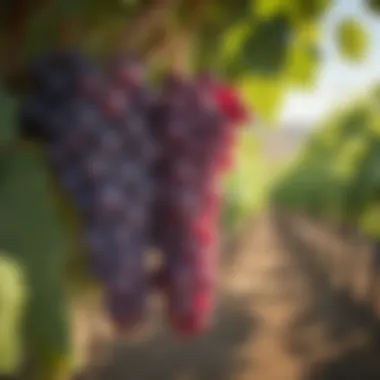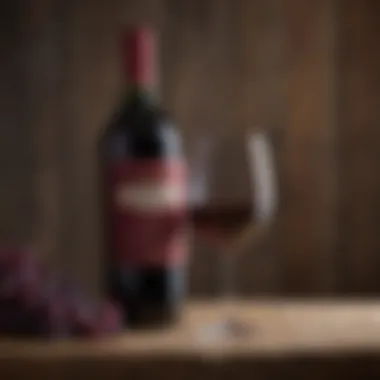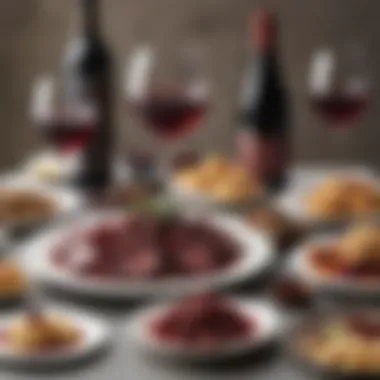Exploring the Best Red Zinfandel: A Comprehensive Guide


Intro
Red Zinfandel stands out as a captivating varietal within the world of wines, celebrated for its complexity and rich flavor profile. Often found in California vineyards, it boasts a significant history that dates back to the 19th century. The blend of ripe fruit characteristics, balanced acidity, and intriguing earthy undertones makes Zinfandel appealing to both casual wine drinkers and connoisseurs alike.
Understanding Red Zinfandel requires a closer look at its production methods and tasting notes. This article aims to provide a thorough exploration of Zinfandel, guiding enthusiasts through its diverse characteristics, ideal food pairings, and recommendations for top varietals. In crafting this guide, we intend to empower readers with knowledge that enhances their wine-tasting experiences.
Preface to Red Zinfandel
Red Zinfandel holds a significant place in the world of wine. Its rich flavor profile and versatility make it a favorite among many wine enthusiasts. This section serves as an introductory overview of what makes Red Zinfandel unique. By understanding its origin, history, and the properties of Zinfandel grapes, readers can appreciate this wine more deeply.
Origin and Historical Significance
Red Zinfandel finds its roots in the early 19th century in the United States, particularly in California. However, its ancestry traces back to ancient vineyards in Europe. The grape is genetically similar to the Croatian grape, Crljenak Kaštelanski. This connection highlights the long history of Zinfandel and its journey across continents.
In the mid-1900s, Zinfandel was often regarded as a lesser grape, overshadowed by varietals like Cabernet Sauvignon. However, as wine culture expanded in the United States, Zinfandel began to receive much-deserved recognition. Today, it is considered a hallmark of California wine. The various regions—such as Napa Valley and Sonoma County—have developed different expressions of Zinfandel, showcasing the grape's versatility.
Understanding Zinfandel Grapes
Zinfandel grapes are medium to large in size and exhibit thin skins. This thinness plays a crucial role in the wine's overall character and aging potential. The grapes thrive in warm climates due to their natural high sugar content. This attribute leads to an alcohol-rich wine, often presenting intense flavors.
The flavor profile of Zinfandel can range from brambly fruits like blackberry and raspberry to more complex notes including pepper, spice, and even jammy characteristics. The ripening process affects these flavors significantly. Grapes picked earlier yield wines with brighter acidity while later-harvested Zinfandels often produce richer, more robust wines.
By understanding these fundamental aspects of Red Zinfandel, the reader will be equipped to explore its complexities through tasting and selection. The subsequent sections will build upon this foundation, guiding wine lovers through the winemaking process, regional variations, and selecting the safest varietals.
"Red Zinfandel, with its rich history and complex flavors, remains one of the defining wines of California."
Identifying the essence of this grape enriches the experience of enjoying this wine. As we proceed to delve deeper into the winemaking process, one becomes aware of how these initial characteristics evolve into the final product.
Winemaking Process of Red Zinfandel
The winemaking process of Red Zinfandel is essential to the creation of this vibrant and flavorful wine. It involves meticulous steps that translate the raw grape into a polished drink. Understanding this process can deepen one’s appreciation for the rich characteristics Zinfandel offers. Each phase in winemaking offers unique benefits and considerations, impacting the final product.
Harvesting Techniques
Harvesting is a critical first step in winemaking. The timing of the grape harvest is vital. Grapes for Red Zinfandel are often harvested late in the season, allowing them to achieve optimum ripeness. Many producers favor hand harvesting. This method ensures that only the best grapes are selected. Handpicking minimizes damage to the grapes and allows for better quality control.
Mechanical harvesting is another method, especially useful for larger vineyards. This process is more efficient and quicker but might result in the collection of less ripe grapes. The choice of harvesting technique can greatly affect the flavor profile of the wine. Therefore, producers choose based on their goals and vineyard conditions.
Fermentation and Aging
After harvesting, the next phase is fermentation. Red Zinfandel fermentation typically begins with destemming followed by crushing the grapes. Yeast is then added, initiating the fermentation process. During this stage, sugar converts into alcohol, producing carbon dioxide. This process lasts from several days to weeks.
Following fermentation, aging is crucial. Red Zinfandel can be aged in oak barrels or stainless steel tanks. Oak barrels contribute unique flavors like vanilla and spice. Aging enhances the wine's complexity as it interacts with the wood. Some producers choose shorter aging processes for fresher wines, while others may age their Zinfandels longer for deeper flavors.
Regional Variations
The characteristics of Red Zinfandel can vary significantly depending on the region of production. California, particularly Napa and Sonoma, is known for its robust and fruit-forward Zinfandels. In contrast, Zinfandels from the Sierra Foothills might possess more earthy and rugged qualities. These regional differences stem from varying climates, soil types, and winemaking traditions.
Understanding these regional variations helps wine lovers choose the right Zinfandel to suit their taste preferences. Each bottle tells a story influenced by its origins, making exploration rewarding for the discerning consumer.
"The magic of winemaking lies in how each step, from harvesting to aging, shapes the final product."
The winemaking process serves as the backbone of the Zinfandel experience, connecting grape to glass in an intricate dance of art and science. By focusing on these processes, enthusiasts can appreciate the skill and dedication that go into producing a quality bottle of Red Zinfandel.
Tasting Red Zinfandel


Tasting Red Zinfandel is a fundamental aspect of understanding this wine. Engaging with its taste is not simply an act of consumption but an exploration of complex layers and nuances that characterize each varietal. The importance of tasting lies in its ability to reveal the wine's heritage, regional influences, and even the winemaker’s philosophy. Through tasting, one gains insights into what makes Red Zinfandel distinctive, which shapes the overall appreciation of this wine.
Aroma and Flavor Profile
The aroma and flavor profile of Red Zinfandel is rich and varied. Aromas often include ripe fruits such as blackberries, cherries, and plums, with a hint of spice. Sometimes you may also detect notes of chocolate or vanilla, especially if the wine has been aged in oak barrels. These elements come together to create a bouquet that is inviting.
On the palate, the flavors unfold. Typically, these wines are marked by a balance of fruitiness and acidity. The fruit flavors present can reflect the specific growing region, showcasing differences between Zinfandels from Napa Valley and those from Sonoma County. A well-made Red Zinfandel may provide a lingering finish, marked by its tactile smoothness due to its moderate tannins. Many enthusiasts appreciate how the flavor can evolve as the wine breathes, revealing new complexities.
Visual Assessment
Visual assessment is a crucial part of tasting Red Zinfandel. When you pour the wine, observe its color and clarity. Most Red Zinfandels have a deep ruby or violet hue, which indicates the richness of the fruit character. A young Zinfandel may appear brighter, while an older version may show more brick-like tones due to oxidation.
Look for clarity; a clear wine often signals a careful filtration and production process. Swirling the glass allows you to assess the wine’s legs, or tears—this can give hints about the alcohol content and viscosity. A thicker tear may suggest a rich body, while thinner ones can imply a lighter texture. Taking time to observe these qualities sets the stage for a fuller tasting experience.
Mouthfeel and Finish
Mouthfeel is an integral component of tasting Red Zinfandel. It refers to the texture of the wine in your mouth. Red Zinfandels can vary from light to full-bodied, and this is largely influenced by factors such as grape ripeness and winemaking techniques.
In terms of finish, this is where you decide whether a wine is worth savoring. A good Red Zinfandel typically has a medium to long finish, which invites you to reflect on the tasting. Whether it leaves a fruity impression, a hint of sweetness, or a spicy bite, the finish can significantly affect your overall judgment. The combination of mouthfeel and finish encapsulates the essence of the wine, reinforcing why tasting is an art form in itself.
"A sophisticated palate appreciates the depth and breadth of flavor and aroma, finding joy in the subtleties of each sip."
Understanding these elements can elevate one's appreciation for Red Zinfandel. Ultimately, tasting is not just about consumption but enjoying the full spectrum of sensations that the wine offers.
Best Red Zinfandel Varietals
Red Zinfandel holds a special place in the world of wines, particularly due to its rich profiling and versatility. Identifying the best varietals is essential. This helps enthusiasts choose quality wines that enhance tasting experiences. Varietals tell a lot about the different flavor profiles, aging capabilities, and even the terroir, which refers to the environmental factors that affect a crop's phenotype.
Top Producers in California
California stands as the undisputed leader in Zinfandel production. Several top producers have contributed significantly to the reputation of this varietal. Some of the most acclaimed brands include:
- Ridge Vineyards has a long-standing history of producing exceptional Zinfandels, recognized for their complexity and aging potential.
- Turley Wine Cellars specializes in Zinfandel from old vines, known for intense flavors and a touch of earthiness.
- Seghesio Family Vineyards offers approachable Zinfandels with fruit-forward profiles accompanied by subtle spice notes.
These producers uphold quality through meticulous attention to detail in both vineyards and winemaking processes. Their wines not only represent the best of Californian Zinfandel but also invite exploration and enjoyment.
Napa Valley vs. Sonoma County
When discussing the geographical variances of Red Zinfandel, two regions often come to the forefront: Napa Valley and Sonoma County. Each area offers distinctive characteristics influenced by its climate and soil.
- Napa Valley Zinfandels tend to have a full-bodied character. They often display ripe fruit flavors and are aged in oak barrels, lending a certain richness.
- Sonoma County produces Zinfandels that might be more varied. This region often highlights a fresher style, with floral and herbal notes intermingling with the fruitiness.
Both regions produce excellent wines, but the choice between them often comes down to personal preference regarding flavor profiles and styles.
Notable Craft Producers
In addition to large brands, several craft producers deserve recognition. These artisans often focus on small-batch production, sometimes using traditional methods. They champion authenticity and often showcase unique takes on Zinfandel.
- Carlisle Winery & Vineyards is known for its old-vine Zinfandel, focusing on sustainability and minimal intervention.
- Pax Mahle Wines offers a distinctive approach, favoring co-fermentation and natural fermentation. This leads to expressive and nuanced wines.
- Merry Edwards Winery introduces a different cultivation perspective, emphasizing precision viticulture and small-lot production.
Choosing a craft producer could lead to discovering hidden gems in the Zinfandel world. Each bottle has a story, reflecting the terroir and the winemaking philosophy of the producer.
Food Pairings with Red Zinfandel
Food pairing is vital in enhancing the enjoyment of Red Zinfandel. The wine's bold flavors and versatile nature can elevate a meal when coupled with the right dishes. Understanding how to match this wine with food not only amplifies the tasting experience but also reflects an appreciation for culinary arts. Each combination brings out unique characteristics in both the wine and the food. Here, we explore how various meals complement Red Zinfandel, enriching the palate and making dining more enjoyable.
Red Meats and Zinfandel


Red meats are a classic pairing with Red Zinfandel. The wine's rich fruitiness harmonizes with the savory flavors of meats like beef, lamb, or pork. For example, a grilled ribeye steak paired with a well-structured Zinfandel creates a balance that highlights the natural juices of the meat. The tannins in Zinfandel can cut through the fat of marbled cuts, ensuring that the flavors of both the wine and the meat are pronounced.
Some specific examples include:
- BBQ Ribs: The sweet and smoky elements of BBQ ribs amplify Zinfandel's fruity notes.
- Roast Lamb: Offers gameiness that complements the complexity of a quality Zinfandel.
Choosing the right preparation method is crucial. Grilling and roasting tend to bring out the best in both the meat and the wine.
Spicy Dishes
Zinfandel also pairs wonderfully with spicy dishes, balancing heat and flavor. The fruit-forward profile of Zinfandel can soften the impact of spice while enhancing the overall taste. Whether it is a spicy barbecue sauce or a hot curry, the right Zinfandel can provide a refreshing contrast that allows the dish's flavors to shine.
- Indian Cuisine: Dishes like Chicken Tikka Masala, which includes cream and spices, create a delightful interplay with Zinfandel's fruitiness.
- Sichuan Dishes: The numbing spice from these foods can be offset by the wine's juicy qualities, making them a good match.
Consider the spice level when selecting a vintage. A more fruity Zinfandel can better handle intense heat.
Cheese and Charcuterie Pairings
Cheese and charcuterie boards offer an ideal way to experience Red Zinfandel. The various textures and flavors found in cheeses and cured meats complement the wine's profile. Zinfandel's acidity works well with aged cheeses, enhancing their depth.
- Aged Cheddar: Its sharpness contrasts effectively with Zinfandel's bold fruit.
- Salami: The fatty, savory elements of salami create a rich pairing that resonates with the wine's character.
Building a charcuterie board around Zinfandel allows for exploration and customization, offering numerous combinations that cater to diverse tastes.
Tip: Serve the wine slightly chilled to maximize its refreshing qualities with cheese and meats.
Buying Tips for Red Zinfandel
When it comes to purchasing Red Zinfandel, there are several key considerations that will enhance your overall experience. Understanding the nuances of wine buying is essential. The selection process can feel overwhelming, especially with the extensive range of varietals available in the market. This section aims to simplify the buying journey by focusing on specific elements which can improve your selection and ensure satisfaction with your purchase.
Understanding Labels
Reading a wine label is fundamental in selecting a quality bottle of Red Zinfandel. Each label provides important information regarding the wine's origin, vintage, alcohol content, and characteristics. Here are some components to look out for:
- Region: Knowing the specific region can indicate the flavor profile and quality. For example, Zinfandels from Napa Valley often exhibit intense fruit flavors, while those from Sonoma can be more subdued.
- Vintage: The vintage year may also affect taste. Generally, better vintages yield more exceptional wines. Research the specific years and their reputation in producing high-quality Zinfandel.
- Alcohol Content: Higher alcohol content can enhance the perception of sweetness in Zinfandel wines. Typical ranges for Red Zinfandel vary from 14% to 16%. Be mindful of this aspect depending on your preferences.
By closely examining these elements on the label, buyers can make informed decisions when selecting Red Zinfandel that aligns with their taste expectations.
Evaluating Price Points
Price can serve as an indicator of quality, but it is also crucial to evaluate what you get for your investment. The cost of Red Zinfandel can vary based on several factors:
- Brand Reputation: Well-known producers may charge more because of their established quality.
- Production Techniques: Limited production wines or those using traditional methods may feature higher price points.
- Availability: Wines that are hard to find often command a premium due to demand.
However, you can find excellent wines at various price points. It's beneficial to sample a range and establish what level provides the best experience for your value preferences. Remember, a higher price does not always equate to better taste.
Where to Purchase
Finding the right venue for buying Red Zinfandel can enhance your buying experience. Different options present their advantages:
- Local Wine Shops: Often, these establishments feature knowledgeable staff who can provide insights and recommendations based on your specific tastes. It is also a great chance to try local options.
- Online Retailers: E-commerce platforms often provide extensive selections and the convenience of home delivery. Look for established retailers with good reputations, such as Wine.com or Total Wine.
- Wineries: Visiting wineries in California can establish a direct connection with the producers. Many wineries offer exclusive deals on their varietals, and a visit may allow you to taste before buying.
Storing and Serving Red Zinfandel
Storing and serving Red Zinfandel effectively are vital components of enhancing its flavors and ensuring a pleasurable drinking experience. The character of a wine can change significantly depending on how it is stored and served. Proper techniques can preserve the wine's integrity and enhance its pleasure. Let's delve into each area in detail.
Optimal Storage Conditions


For Red Zinfandel to reach its full potential, it is crucial to store it under optimal conditions. The storage environment can drastically affect the wine’s flavor profile and longevity. Key elements to consider include:
- Temperature: Red Zinfandel should be stored at a consistent temperature, ideally between 55°F to 65°F (13°C to 18°C). Extreme fluctuations can impact the aging process and degrade the wine.
- Humidity: Aim for a humidity level of around 60% to 70%. Excessive dryness can dry out corks, while high humidity can encourage mold growth.
- Light: Keep the wine away from direct sunlight or bright artificial lights. Exposure can lead to chemical reactions that impair the quality of the wine.
- Positioning: Store bottles horizontally when possible to keep the cork moist and prevent air from entering the bottle.
By adhering to these conditions, you can better preserve the unique qualities of your Red Zinfandel, ensuring that it remains enjoyable when you are ready to savor it.
Decanting and Aeration
Decanting and aeration are essential practices when serving Red Zinfandel. These methods allow the wine to breathe, enhancing its flavors and aromas. Here are important aspects to consider:
- Decanting: Pouring Red Zinfandel from its bottle into a decanter can separate the wine from sediment and introduce oxygen. This process can improve the overall taste. It is often recommended to decant young Zinfandels for about 30 minutes to an hour before serving.
- Aeration: Allowing wine to interact with air helps release volatile compounds, which in turn enhances the aroma. This is particularly useful for robust and full-bodied Zinfandels that may initially seem tight on the palate. Simple aeration can occur simply by swirling the wine in a glass before tasting.
In summary, the methods of storing and serving are not just procedural; they play a crucial role in experiencing the nuances of Red Zinfandel. Proper storage ensures the wine remains in excellent condition, while decanting and aeration elevate the drinking experience to a new level of appreciation.
Cultural Impact of Red Zinfandel
The cultural significance of Red Zinfandel extends beyond its flavor profile and regional production. This varietal serves as a reflection of agricultural practices, historical developments, and social shifts within American society. As we explore its cultural impact, we particularly focus on two crucial elements: its representation in popular media and its role in shaping American wine culture.
Zinfandel in Popular Media
Red Zinfandel has found a place in various forms of popular media. Whether through film, television, or literature, this wine has been portrayed as a symbol of sophistication and leisure. In many instances, it represents the allure of California's wine country.
For example, you may see characters in movies enjoying a glass of Zinfandel while engaging in intimate conversations, showcasing not only the wine itself but also the lifestyle it embodies. Television cooking shows and gastronomy-focused series often highlight Red Zinfandel in food pairings, encouraging viewers to explore its versatility.
Furthermore, social media platforms like Instagram allow individuals to share their wine experiences, often featuring Zinfandel prominently. Hashtags related to this varietal encourage users to document their wine selections, further popularizing it in daily conversations about gastronomy.
Role in American Wine Culture
Red Zinfandel plays a central role in American wine culture. As one of the few grape varieties that is distinctly American, it represents a unique contribution to the global wine narrative. Zinfandel's adaptability to various soils and climates has established its reputation across numerous regions, especially California.
Moreover, Red Zinfandel is often seen as a gateway wine for those new to exploring the world of wine. Its fruit-forward characteristics and willingness to complement an array of foods make it a popular choice for gatherings and casual meet-ups.
In addition, wine enthusiasts frequently participate in tastings and festivals that celebrate this varietal. These events often serve as community-building platforms, fostering a connection among attendees who share an appreciation for wine.
"Red Zinfandel is not just a wine; it's a cultural phenomenon that reflects the rich tapestry of American history and society."
As you can see, the cultural impact of Red Zinfandel is substantial. It encompasses various aspects of today's social landscape and highlights its important place within the framework of American culinary arts. Understanding this wine's significance inspires deeper appreciation and invites exploration of its myriad expressions.
Closure
In this article, we have carefully examined the various aspects of Red Zinfandel, a wine that reflects both its historical roots and modern production techniques. Understanding these nuances is vital for anyone looking to appreciate or select the best bottles of this rich and versatile wine. Red Zinfandel is not just a drink; it is a cultural artifact that resonates with many wine enthusiasts and casual drinkers alike, thanks to its appealing flavors and food pairing capacities.
Recap of Key Insights
First, we explored the origin and historical significance of Red Zinfandel, tracing its journey from old vineyards to contemporary winemaking. The historical context enriches our understanding of why this varietal maintains its popularity.
Next, we delved into the winemaking process, highlighting how techniques such as harvesting, fermentation, and aging affect the final product. Each winemaker brings a unique approach, offering a spectrum of flavors and styles.
We also analyzed how to taste Red Zinfandel properly, focusing on its aroma, visual appeal, and mouthfeel. This knowledge equips readers to make informed choices when selecting a bottle.
In discussing the best varietals, we took a closer look at different producers, comparing regions such as Napa Valley and Sonoma County, which host some of the most esteemed wineries. This comparison is crucial for understanding the diversity of this wine.
Food pairings are essential for enhancing the consumption experience of Red Zinfandel. We outlined how certain foods benefit from this wine, including red meats and spicy dishes.
Finally, we provided buying tips, practical advice for storing, serving, and considering future wine trends. Understanding the labels and evaluating price points are significant steps for both new and seasoned buyers.
Future Trends in Red Zinfandel
Looking forward, the future of Red Zinfandel seems promising with evolving industry practices. As consumer preferences shift, producers are experimenting with sustainable farming techniques and organic wines. This innovation could enhance the quality and environmental viability of future vintages.
Additionally, the rise of online wine sales allows a broader audience to access unique varietals, which may lead to an increased appreciation for niche producers. We can expect that new styles and blends will continue to emerge, redefining what enthusiasts expect from this historic varietal.
The ongoing dialogue about food and wine pairing will also influence how Red Zinfandel is served. More chefs and sommeliers are recognizing the versatility of this wine, partnering it with diverse culinary creations.







